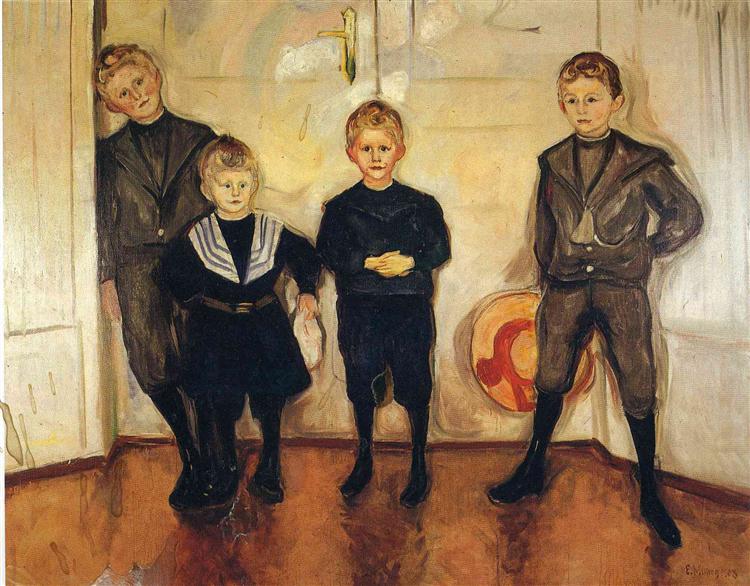Description
The work "The four children of Dr. Linde", painted by Edvard Munch in 1903, is a composition rich in meaning and emotional complexity, which reflects the artist's mastery in the use of color and the way to manifest human psychology. In this painting, Munch explores the relationship between family life and the emotional burden that often accompanies it, a recurring theme in its vast artistic production.
The scene presents four male figures, which are interpreted as the children of Dr. Linde, a character that can symbolize both a father figure and a voice of authority in the life of the children. Each of these characters is arranged in an order that suggests both close and distance, underlining the complexity of family relationships. The figures are not thorough individual portraits, but exist within the painting space as representations of emotional archetypes rather than defined identities. The cut of the composition and disposition of the figures reinforce the interpretation of an underlying tension that defines the family environment.
The use of color in "Dr. Linde's four children" is particularly notable. The predominantly warm tones, such as red and ocher, are intertwined with colder shadows, creating a contrast that highlights the emotional vulnerability of the characters. Munch, known for his ability to evoke emotions through color, uses this palette to illustrate not only the warmth of the home, but also the fragility of human relationships. It is a reminder that love and concern often coexist with anxiety and uncertainty.
The background of the paint is equally significant, with an atmosphere that seems to be impregnated with a sense of restlessness. This space, nebulous and little defined, suggests that the lives of the characters are influenced by external forces, an echo of the artist's own life, marked by loss and suffering. Munch often explored the internal struggles of the individual in the face of social expectations, and in this work you can glimpse that struggle between family membership and the desire for personal independence.
Through his art, Munch reformulated the narrative of symbolism, integrating elements of his personal experiences, which gives his works a universal resonance. "The four children of Dr. Linde" can be seen in continuity with other works by the artist where existential anguish, such as "The cry" or "Madonna", both works that also capture the complexity of the human condition.
While "Dr. Linde's four children" may not be one of Munch's most commented works, his ability to portray intimacy and friction within family dynamics offers a deep study on the nature of relationships in the context of the historical moment that the artist lived. The work remains a testimony of Munch's ability to work at the crossing between the personal and the collective, creating images that resonate with the contemporary existential struggle and that raise still relevant questions about the meaning of the family, identity and emotion human
KUADROS ©, a famous paint on your wall.
Hand-made oil painting reproductions, with the quality of professional artists and the distinctive seal of KUADROS ©.
Art reproduction service with satisfaction guarantee. If you are not completely satisfied with the replica of your painting, we refund your money 100%.

